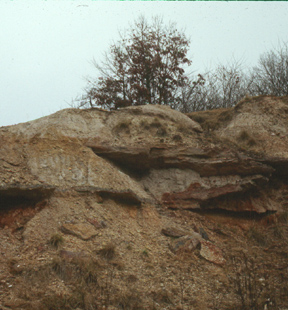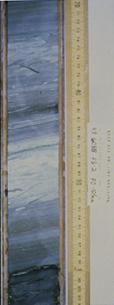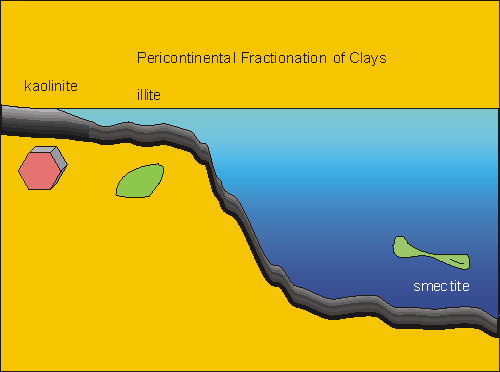Differential Deposition of Clays: Pericontinental Fractionation
Clays can be excellent paleo-climatic indicators when they
have time to form in soils and the soils are developed enough to represent the
prevailing climate. The clays must be eroded from these soils and transported
to a basin with little mixing from concurrently eroding sedimentary rocks or
from soils from a different drainage basin that represents a different type
of climate.
In addition to this stipulation, clays must be deposited
en masse in a basin and not segregated prior to deposition. However,
many studies indicate that segregation does occur, either because of differential
flocculation (Parham, etc) or because of different settling velocities due to
different shapes of clays (Gibbs).
The prevailing idea about the abundance of smectite in Cretaceous
sediment in the North Atlantic was that the abundance of smectite indicated
that there was a monsoonal climate. Smectite formation occurred in low-lying
areas, presumably in vertisols, along the eastern seaboard of North America.
|
Actual paleosols (ancient soils) of Aptian-Albian age
are preserved around Baltimore, Md. Here, paleoinceptisols are interbedded
with crevasse splay deposits of the Potomac Group.
Paleo-ultisols occur in areas farther from stream channels.
These have clay-enriched E horizons.
The clay mineral composition of these paleosols is
dominantly kaolinite, with detrital illite that
was probably shed from Paleozoic shales of the Appalachians just to the
west.
No paleovertisols were observed in this outcrop.
|
 |
|
Aptian-Albian sediment from just offshore the New Jersey
coast, in the Baltimore Canyon Trough, comprises deltaic sand and interbedded
mud.
The dominant clay is illite, here shown undergoing
dissolution. There is an almost equal amount of kaolnite and no or only
traces of smectite.
Roll mouse over the image to see illite and kaolinite.
|
 |
|
Turbidites interbedded with cyclic pelagic black shale
and calcareous (nannofossil) ooze of Aptian-Albian age just offshore the
Baltimore Canyon Trough.
The black shales contain dominantly smectite (identified
by x-ray diffraction). Turbidite beds are richer in kaolinite and illite
than pelagic layers.
|
 |
These data indicate that pericontinental fractionation, or
the differential deposition of clays at the edge of a continent, has sorted
clay and led to a skewed "paleoclimate" signal in sediment of the
North Atlantic. Kaolinite and illite are trapped on the shelf, while smectite
escapes to the deep sea.
|
Kaolinite may flocculate first as clays reach the salty
sea because of its low charge and low cation exchange capacity (CEC),
or it may settle first because of its equant shape.
Illite has a higher CEC and a platy morphology. It
is wafted farther out onto the shelf.
Smectite has the highest CEC and a flaky morphology
that resists deposition. It tends to accumulate in the pelagic environment,
the deep sea.
Turbidites bring sediment from the shelf to the deep
sea, enriching pelagic sediment in "shelf" components, such
as illite and kaolinite.
Interpretation of paleoclimate from clay composition
must be done with caution. The best way to do this is to use clays in
place, in situ, such as in paleosols.
|
 |
References
Chamley, H., 1979. North Atlantic clay sedimentation and
paleoenvironment since the late Jurassic. In Talwani, M., Hay, W., and Ryan,
W. B. (Eds.), Deep Drilling Results in the Atlantic Ocean: Continental Margins
and Paleoenvironment. Am. Geophys. Union, Maurice Ewing Ser. 3:342-361.
Gibbs, R. J., 1977. Clay mineral segregation in the marine
environment. Jour. Sed. Petr. 47(1):237-243.
Holmes, M. A., 1987. Clay mineralogy of the Lower Cretaceous
deep-sea fan, deep sea drilling project site 603, lower conti-nental rise of
North Carolina. Init. Repts., DSDP, 92:1079-1089 (U.S. Govt. Printing Office,
Washington).
Lonnie, T. P., 1982. Mineralogic and chemical comparison
of marine, nonmarine, and transitional clay beds on south shore of Long Island,
New York. Jour. Sed. Petr. 52(2):529-536.
Parham, W. E., 1966. Lateral variations of clay mineral assemblages
in modern and ancient sediments. Proc. Intn'l. Clay Conf. 1:135-145.
Porrenga, D. H., 1966. Clay minerals in recent sediments
of the Niger delta. Clays Clay Minerals, 14th natl. conf., Pergam-mon, Oxford,
New York:221-233.
Singer, A., 1984. The paleoclimatic interpretation of clay
minerals in sediments - a review. Earth-Sci. Rev., 21:251-293.


